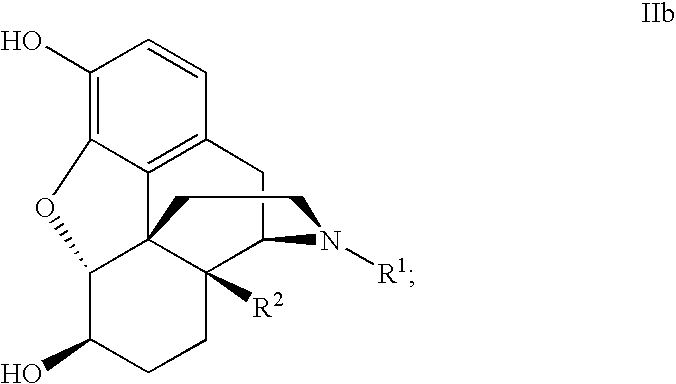PROCESS FOR MAKING MORPHINAN-6alpha-OLS
a technology of morphinan-6alpha-ols and morphinan-6alpha-ols, which is applied in the field of process for the manufacture of morphinan-6alpha-ols, can solve the problems of inability to commercialize, inability to remove contaminant, and inability to meet the requirements of the application
- Summary
- Abstract
- Description
- Claims
- Application Information
AI Technical Summary
Problems solved by technology
Method used
Image
Examples
example 1
Conversion of Noroxymorphone to Noroxymorphol(14-Hydroxydihydronormorphine)
[0056]
[0057]Noroxymorphone (5 g) was suspended in water (75 ml). The pH was adjusted to 13.3 with aqueous solution of NaOH (40% weight / volume (w / v)). The solution was warmed to 50° C. and aged with stirring until complete dissolution was observed. To this solution was added Adams catalyst (PtO2, 50 mg) and the mixture was hydrogenated at 40 psi at room temperature for 3.5 h with 1200 rpm agitation speed. The catalyst was then removed with 5 ml water rinse. The pH was adjusted to 9.1 with glacial acetic acid and the resulting suspension was aged for 1 h. The suspension was filtered with a small volume of water rinse. The solid was dried at 60° C. under vacuum for 5 h (3.80 g, 76% yield by weight, overall yield / accountability was estimated to be approximately 90% taking into account the aliquots taken for sampling and the material lost to the mother liquor). The solid isolated was characterised to be 6(α)-norox...
example 2
Conversion of Oxymorphone to Oxymorphol(14-Hydroxydihydromorphine)
[0058]
[0059]Oxymorphone (5 g, assay=84.7%) was suspended in water (200 ml). The pH was adjusted to 13.2 with aqueous solution of NaOH (40% w / v). The solution was warmed to ˜50° C. and aged with stirring until complete dissolution was observed. To this solution was added Adams catalyst (PtO2, 50 mg) and the mixture was hydrogenated at 40 psi at room temperature for 9 h with 1200 rpm agitation speed. The catalyst was then removed with 5 ml water rinse. The pH was adjusted to 9.1 with glacial acetic acid. No precipitation was observed. The solution was then concentrated in vacuo at 65° C. to a volume of approximately 75 ml. The resulting suspension was cooled to room temperature, aged for 1 h and filtered with 5 ml water rinse. The solid was dried at 60° C. under vacuum for 4 h (3.45 g, 82% yield by weight). The solid was characterised to be 6(α)-oxymorphol(14-hydroxydihydromorphine). The 1-isomer was at 0.02% by HPLC an...
example 3
Conversion of Nalbuphone to Nalbuphine
[0060]
[0061]A 500 ml three necked round bottom flask was charged with crude Nalbuphone Hydrochloride (50 grams, 93.14 mmol), sodium acetate (0.77 grams, 9.31 mmol), activated charcoal (2 grams, Norit CAP Super) and water (300 mL). Subsequently, the mixture was heated (batch temperature of 80° C.) under reduced pressure (p=250 mbar). A total amount of 16.7 g distillate was collected at an internal temperature of 55-65° C. during 40 minutes. The vacuum supply was then removed and the mixture stirred at a temperature of 65° C. for 1 hour. Subsequently, the mixture was filtered through a 2 cm pad of diatomaceous earth (Celite) and the filter cake rinsed with water (two 15 mL aliquots) to give: 359.5 g of a yellow solution containing 89.1 mg / g=32.02 g=90.1 mmol=96.7% nalbuphone (as the hydrochloride salt).
[0062]A 1 liter round bottom flask was charged with sodium hydroxide solution (30%, 24.8 grams, 186.3 mmol) and 2-propanol (160 mL). The above solu...
PUM
| Property | Measurement | Unit |
|---|---|---|
| temperatures | aaaaa | aaaaa |
| temperatures | aaaaa | aaaaa |
| w/w | aaaaa | aaaaa |
Abstract
Description
Claims
Application Information
 Login to View More
Login to View More - R&D
- Intellectual Property
- Life Sciences
- Materials
- Tech Scout
- Unparalleled Data Quality
- Higher Quality Content
- 60% Fewer Hallucinations
Browse by: Latest US Patents, China's latest patents, Technical Efficacy Thesaurus, Application Domain, Technology Topic, Popular Technical Reports.
© 2025 PatSnap. All rights reserved.Legal|Privacy policy|Modern Slavery Act Transparency Statement|Sitemap|About US| Contact US: help@patsnap.com



